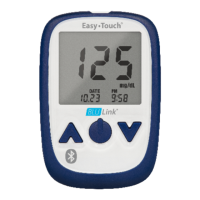
Do you have a question about the MHC Medical Products EasyTouch BluLink and is the answer not in the manual?
| Brand | MHC Medical Products |
|---|---|
| Model | EasyTouch BluLink |
| Category | Blood Glucose Meter |
| Intended Use | Self-monitoring of blood glucose levels |
| Sample Volume | 0.5 μL |
| Test Time | 5 seconds |
| Measuring Range | 20-600 mg/dL |
| Hematocrit Range | 30-55% |
| Operating Temperature | 50-104°F (10-40°C) |
| Operating Humidity | 10-90% RH |
| Connectivity | Bluetooth |
| Power Source | 2 x AAA batteries |
| Sample Type | Capillary whole blood |
Lists all the items included in the EasyTouch® BluLink® Blood Glucose Monitoring System kit.
Details the test strip port for insertion and the display screen for results.
Explains the function of buttons for power, entering data, and navigation.
Describes the test strip ejector and the data port for PC connection.
Explains various symbols like low battery, alarm, and troubleshooting indicators.
Identifies key parts of the test strip: target, confirmation window, and contact bar.
Emphasizes reading instructions and following safety precautions to prevent infection.
Discusses factors like dehydration and hematocrit that may affect meter accuracy.
Provides guidelines for preparing and conducting tests for lab result comparison.
Covers powering on, setting user activity, and configuring the year.
Instructions for setting the date, time, and test units on the meter.
Details on setting alarms on/off, alarm time, and programming multiple alarms.
Provides assistance contact, notes on year/average settings, and cautions.
Explains the meter's automatic code recognition feature for test strips.
Warns against bending test strips or using damaged code labels.
Lists scenarios where using control solution is recommended for accuracy checks.
Covers checking expiration, shaking solution, discarding the first drop, and dipping the strip.
Reminds to repeat with both levels and how to differentiate control tests.
Provides example ranges for Low and High control solutions, noting they are examples.
Recommends storage temperature and checking expiration/discard dates.
Steps to take if control solution tests fall out of range and when to contact support.
Guides on careful disposal of used control solution and test strips.
Details inserting the test strip and ensuring the code number matches the vial.
Addresses issues with code display, mismatches, and sample application timing.
Reiterates single patient use and the biohazardous nature of kit components.
Covers unscrewing the cap, inserting the lancet, and replacing the cap.
Guides on adjusting depth setting and how to prick the finger.
Details on applying the blood sample to the test strip and the automatic countdown.
Warns about countdown issues, test timeouts, and incomplete sample fills.
Explains how results are displayed and how to use the activity/meal feature.
Advises on interpreting results matching symptoms and refers to disposal instructions.
Instructions on removing and disposing of used test strips from the meter.
Instructions on safely disposing of used twist lancets.
How to access and view previous blood sugar test results stored in the meter.
How to display and review average blood glucose readings over different periods.
Guidance on how to perform blood glucose tests using alternate body sites.
Specific instructions for sampling from the ventral/dorsal palm and fingertips.
Techniques for sampling from the forearm, upper arm, thigh, and calf.
Recommends fingertip testing for hypoglycemia and cleaning sites for alternate sampling.
Reiterates the critical warning against sharing lancing devices to prevent infection.
Steps for preparing the lancing device with the clear cap for alternate site testing.
Techniques for rubbing the site, collecting blood, and applying it to the test strip.
Notes AST tip availability and advises consulting a healthcare professional.
Lists conditions where alternate site testing should be avoided, such as rapidly falling glucose.
Explains why cleaning and disinfecting the meter and lancing device is crucial for safety.
Identifies CaviWipes™ Disinfecting Towelettes as the validated cleaning agent.
Step-by-step guide for cleaning and disinfecting the meter using CaviWipes™.
Explains the 2-minute wet contact time needed for effective disinfection.
Warns about liquid exposure, disposal of wipes, and minimum weekly cleaning.
Procedures for cleaning and disinfecting the reusable lancing device.
Recommends weekly cleaning and states the system's expected 3-year life.
Lists signs of deterioration requiring immediate cessation of use and support contact.
Details recommended storage conditions for the meter, test strips, and control solution.
Explains how to transfer test results to a computer via a USB connection.
Describes the meter's ability to transmit data wirelessly via Bluetooth.
Guides on downloading the app, ensuring Bluetooth is active, and initiating pairing.
Details confirming the connection and automatic test data transfer to the app.
Provides notes on automatic transfer triggers and keeping devices close during transfer.
Step-by-step instructions for installing the battery into the meter.
Explains the low battery icon and the process for replacing the battery.
Explains meanings and required actions for error codes Er1, Er2, Er3, and Er4.
Explains meanings and required actions for error codes Er5, Er6, LoF, and H/F.
Explains the 'Lo' indicator, its meaning, and recommended actions.
Explains 'HI' indicator, no readings, inconsistent results, and meter power issues.
Guides on interpreting low (<70mg/dL) and high (>180mg/dL) glucose results.
Provides expected blood glucose values for non-diabetic adults as a reference.
Details the 3-year warranty, its limitations, and exceptions.
Provides instructions for obtaining warranty service and contacting customer support.
Summarizes critical specifications like sample type, test range, and operating conditions.